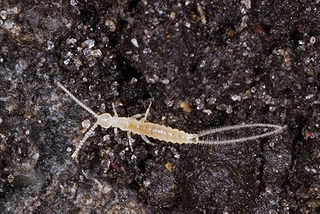
The order Diplura is one of three orders of non-insect hexapods within the class Entognatha. The name "diplura", or "two tails", refers to the characteristic pair of caudal appendages or filaments at the terminal end of the body.
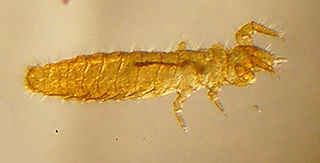
The Protura, or proturans, and sometimes nicknamed coneheads, are very small, soil-dwelling animals, so inconspicuous they were not noticed until the 20th century. The Protura constitute an order of hexapods that were previously regarded as insects, and sometimes treated as a class in their own right.

Millipedes are a group of arthropods that are characterised by having two pairs of jointed legs on most body segments; they are known scientifically as the class Diplopoda, the name derived from this feature. Each double-legged segment is a result of two single segments fused together. Most millipedes have very elongated cylindrical or flattened bodies with more than 20 segments, while pill millipedes are shorter and can roll into a tight ball. Although the name "millipede" derives from Latin for "thousand feet", no species was known to have 1,000 or more until the discovery of Eumillipes persephone, which can have over 1,300 legs. There are approximately 12,000 named species classified into 16 orders and around 140 families, making Diplopoda the largest class of myriapods, an arthropod group which also includes centipedes and other multi-legged creatures.

Centipedes are predatory arthropods belonging to the class Chilopoda of the subphylum Myriapoda, an arthropod group which includes millipedes and other multi-legged animals. Centipedes are elongated segmented (metameric) creatures with one pair of legs per body segment. All centipedes are venomous and can inflict painful bites, injecting their venom through pincer-like appendages known as forcipules. Despite the name, no centipede has exactly 100 pairs of legs; number of legs ranges from 15 pairs to 191 pairs, always an odd number. They are predominantly carnivorous.
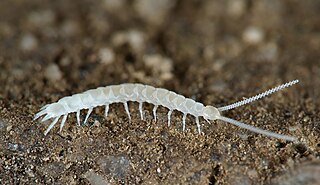
Symphylans, also known as garden centipedes or pseudocentipedes, are soil-dwelling arthropods of the class Symphyla in the subphylum Myriapoda. Symphylans resemble centipedes, but are very small, non-venomous, and only distantly related to both centipedes and millipedes. They can move rapidly through the pores between soil particles, and are typically found from the surface down to a depth of about 50 centimetres (20 in). They consume decaying vegetation, but can do considerable harm in an agricultural setting by consuming seeds, roots, and root hairs in cultivated soil.

An instar is a developmental stage of arthropods, such as insects, between each moult (ecdysis), until sexual maturity is reached. Arthropods must shed the exoskeleton in order to grow or assume a new form. Differences between instars can often be seen in altered body proportions, colors, patterns, changes in the number of body segments or head width. After shedding their exoskeleton (moulting), the juvenile arthropods continue in their life cycle until they either pupate or moult again. The instar period of growth is fixed; however, in some insects, like the salvinia stem-borer moth, the number of instars depends on early larval nutrition. Some arthropods can continue to moult after sexual maturity, but the stages between these subsequent moults are generally not called instars.
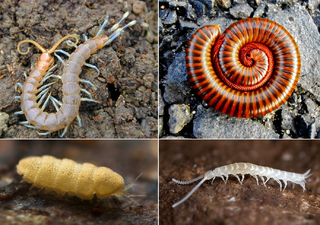
Myriapods are the members of subphylum Myriapoda, containing arthropods such as millipedes and centipedes. The group contains about 13,000 species, all of them terrestrial.

The name Apterygota is sometimes applied to a former subclass of small, agile insects, distinguished from other insects by their lack of wings in the present and in their evolutionary history; notable examples are the silverfish, the firebrat, and the jumping bristletails. Their first known occurrence in the fossil record is during the Devonian period, 417–354 million years ago. The group Apterygota is not a clade; it is paraphyletic, and not recognized in modern classification schemes. As defined, the group contains two separate clades of wingless insects: Archaeognatha comprises jumping bristletails, while Zygentoma comprises silverfish and firebrats. The Zygentoma are in the clade Dicondylia with winged insects, a clade that includes all other insects, while Archaeognatha is sister to this lineage.
The arthropod leg is a form of jointed appendage of arthropods, usually used for walking. Many of the terms used for arthropod leg segments are of Latin origin, and may be confused with terms for bones: coxa, trochanter, femur, tibia, tarsus, ischium, metatarsus, carpus, dactylus, patella.
Insect physiology includes the physiology and biochemistry of insect organ systems.
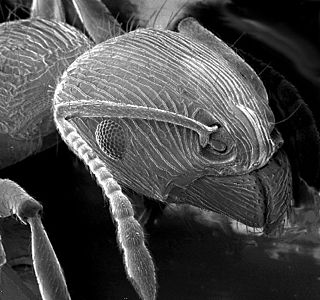
Arthropods are covered with a tough, resilient integument or exoskeleton of chitin. Generally the exoskeleton will have thickened areas in which the chitin is reinforced or stiffened by materials such as minerals or hardened proteins. This happens in parts of the body where there is a need for rigidity or elasticity. Typically the mineral crystals, mainly calcium carbonate, are deposited among the chitin and protein molecules in a process called biomineralization. The crystals and fibres interpenetrate and reinforce each other, the minerals supplying the hardness and resistance to compression, while the chitin supplies the tensile strength. Biomineralization occurs mainly in crustaceans. In insects and arachnids, the main reinforcing materials are various proteins hardened by linking the fibres in processes called sclerotisation and the hardened proteins are called sclerotin. The dorsal tergum, ventral sternum, and the lateral pleura form the hardened plates or sclerites of a typical body segment.

Arthropods are invertebrate animals in the phylum Arthropoda. They possess an exoskeleton with a cuticle made of chitin, often mineralised with calcium carbonate, a segmented body, and paired jointed appendages. In order to keep growing, they must go through stages of moulting, a process by which they shed their exoskeleton to reveal a new one. They are an extremely diverse group, with up to 10 million species.

Polydesmida is the largest order of millipedes, containing approximately 3,500 species, including all the millipedes reported to produce hydrogen cyanide (HCN). Polydesmids grow and develop through a series of moults, adding segments until they reach a fixed number in the adult stage, which is usually the same for a given sex in a given species, at which point the moulting and the addition of segments and legs stop. This mode of development, known as teloanamorphosis, distinguishes this order from most other orders of millipedes, which usually continue to moult as adults, developing through either euanamorphosis or hemianamorphosis.

Crustaceans may pass through a number of larval and immature stages between hatching from their eggs and reaching their adult form. Each of the stages is separated by a moult, in which the hard exoskeleton is shed to allow the animal to grow. The larvae of crustaceans often bear little resemblance to the adult, and there are still cases where it is not known what larvae will grow into what adults. This is especially true of crustaceans which live as benthic adults, more-so than where the larvae are planktonic, and thereby easily caught.

Folsomia candida is a species of springtail in the family Isotomidae. It is found in soil in many locations around the world, having been spread inadvertently by humans. It reproduces by parthenogenesis and has been used as a model organism in research.

The subphylum Hexapoda comprises most species of arthropods and includes the insects as well as three much smaller groups of wingless arthropods: Collembola, Protura, and Diplura. The Collembola are very abundant in terrestrial environments. Hexapods are named for their most distinctive feature: a consolidated thorax with three pairs of legs. Most other arthropods have more than three pairs of legs. Most recent studies have recovered Hexapoda as a subgroup of Crustacea.

Chordeumatida is a large order of millipedes containing some 1200 species with a nearly worldwide distribution. Also known as sausage millipedes, they grow and develop through a series of moults, adding segments until they reach a fixed number in the adult stage, which is usually the same for a given sex in a given species, at which point the moulting and the addition of segments and legs stop. This mode of development, known as teloanamorphosis, distinguishes this order from most other orders of millipedes, which usually continue to moult as adults, developing through either euanamorphosis or hemianamorphosis.

Strigamia maritima is a centipede belonging to the family Linotaeniidae in the order Geophilomorpha. It is the most common of the four fully coastal geophilomorph species known in the British Isles.

Caenocholax fenyesi is a species of twisted-winged parasitic insects in the order Strepsiptera and family Myrmecolacidae. It has a sporadic distribution throughout North America, Central America, and South America. Chaenochlax brasiliensis is the only other named species in the genus.
The centipedes or Chilopoda are divided into five orders, which are grouped into two subclasses, Pleurostigmomorpha and Notostigmomorpha, the latter of which comprises only one order, the Scutigeromorpha.

















